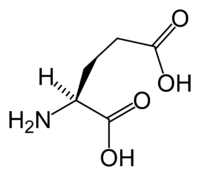
Photo from wikipedia
Summary Fine orchestration of excitatory and inhibitory synaptic development is required for normal brain function, and alterations may cause neurodevelopmental disorders. Using sparse molecular manipulations in intact brain circuits, we… Click to show full abstract
Summary Fine orchestration of excitatory and inhibitory synaptic development is required for normal brain function, and alterations may cause neurodevelopmental disorders. Using sparse molecular manipulations in intact brain circuits, we show that the glutamate receptor delta-1 (GluD1), a member of ionotropic glutamate receptors (iGluRs), is a postsynaptic organizer of inhibitory synapses in cortical pyramidal neurons. GluD1 is selectively required for the formation of inhibitory synapses and regulates GABAergic synaptic transmission accordingly. At inhibitory synapses, GluD1 interacts with cerebellin-4, an extracellular scaffolding protein secreted by somatostatin-expressing interneurons, which bridges postsynaptic GluD1 and presynaptic neurexins. When binding to its agonist glycine or D-serine, GluD1 elicits non-ionotropic postsynaptic signaling involving the guanine nucleotide exchange factor ARHGEF12 and the regulatory subunit of protein phosphatase 1 PPP1R12A. Thus, GluD1 defines a trans-synaptic interaction regulating postsynaptic signaling pathways for the proper establishment of cortical inhibitory connectivity and challenges the dichotomy between iGluRs and inhibitory synaptic molecules.
Journal Title: Neuron
Year Published: 2019
Link to full text (if available)
Share on Social Media: Sign Up to like & get
recommendations!